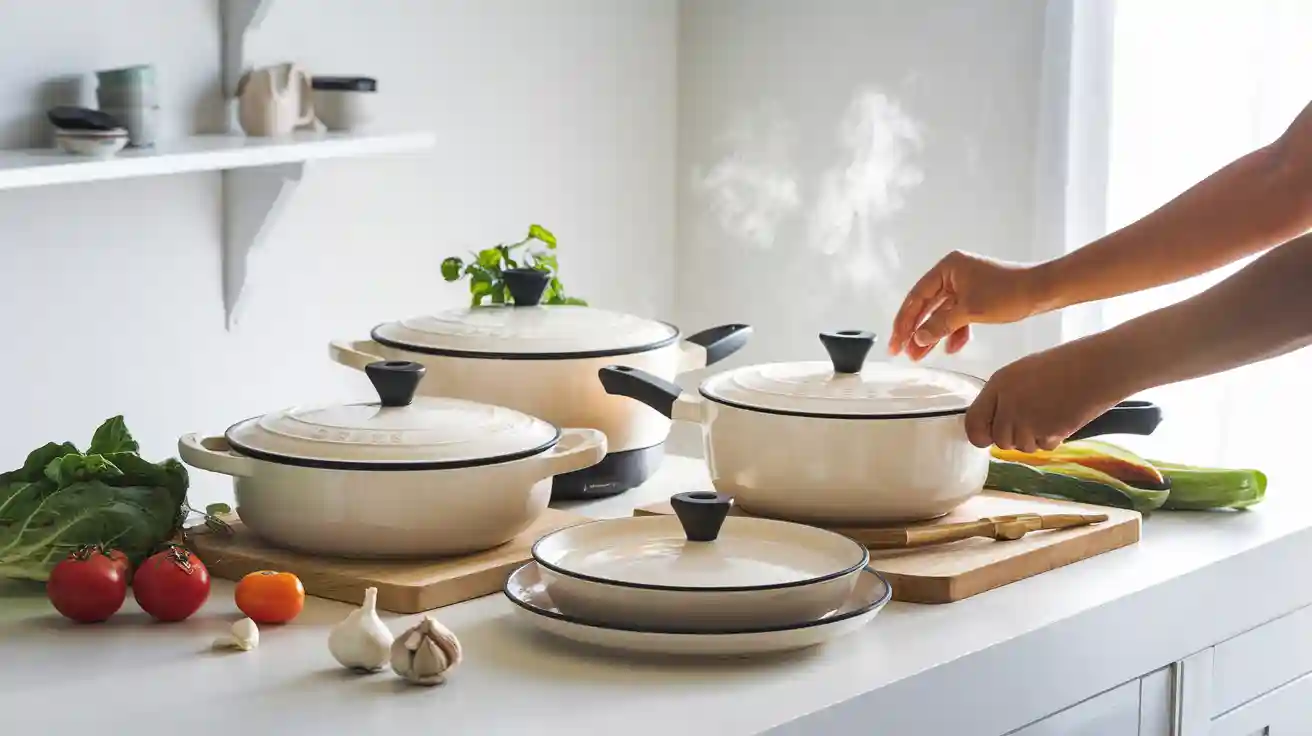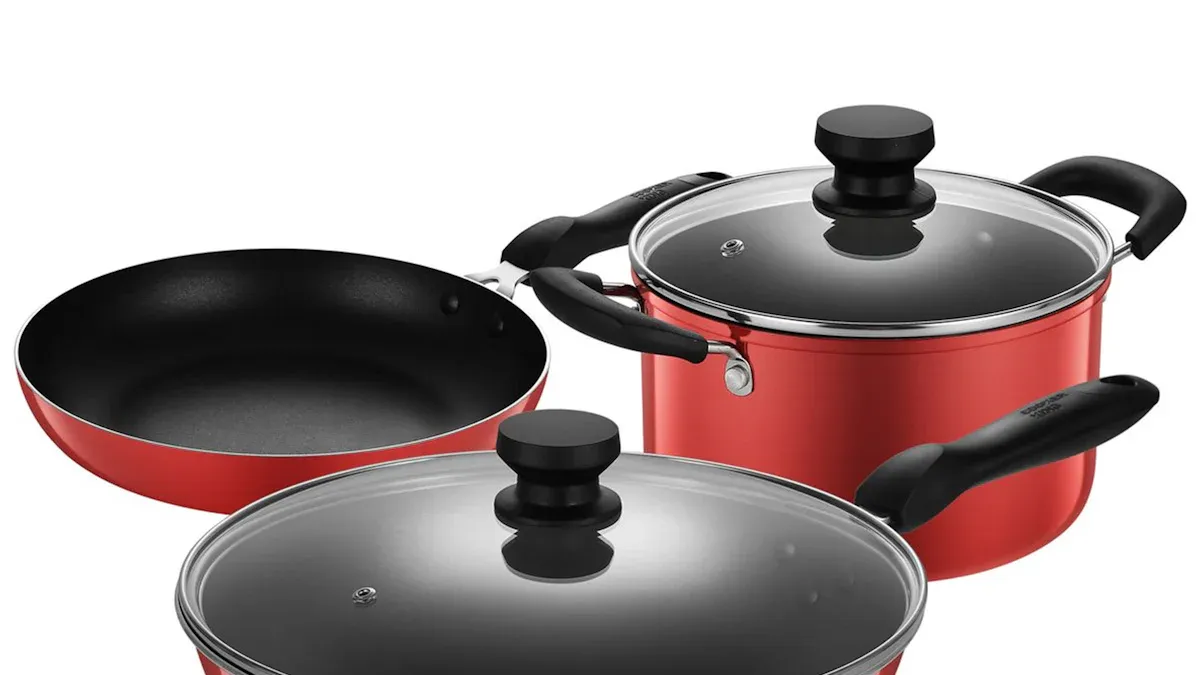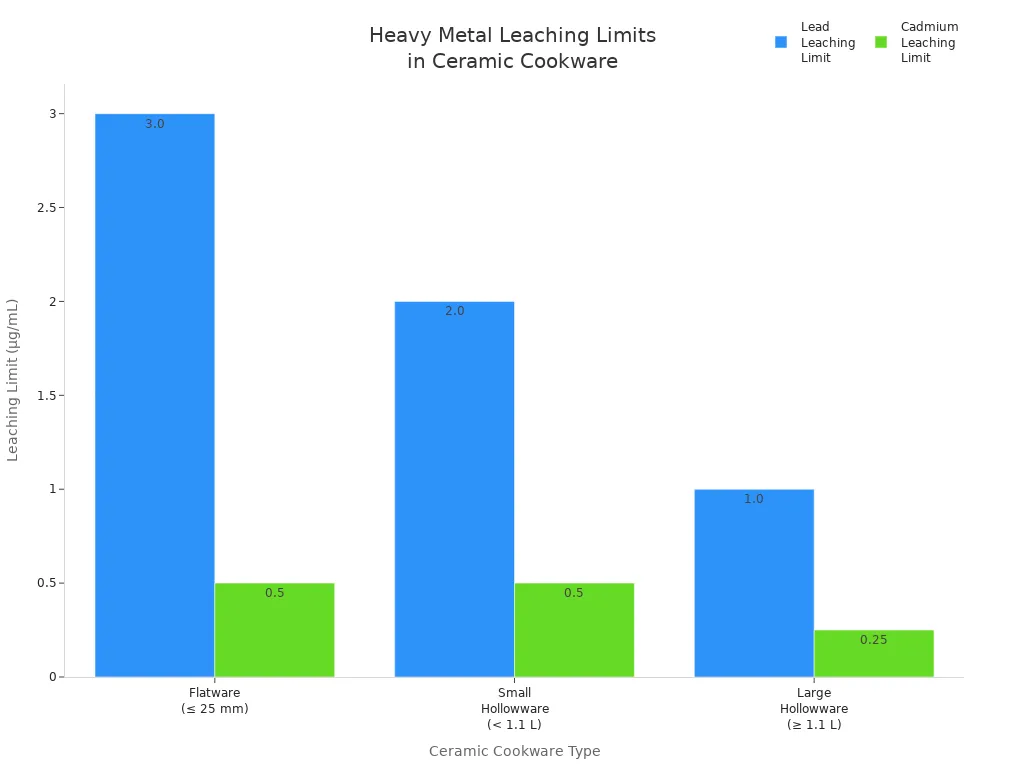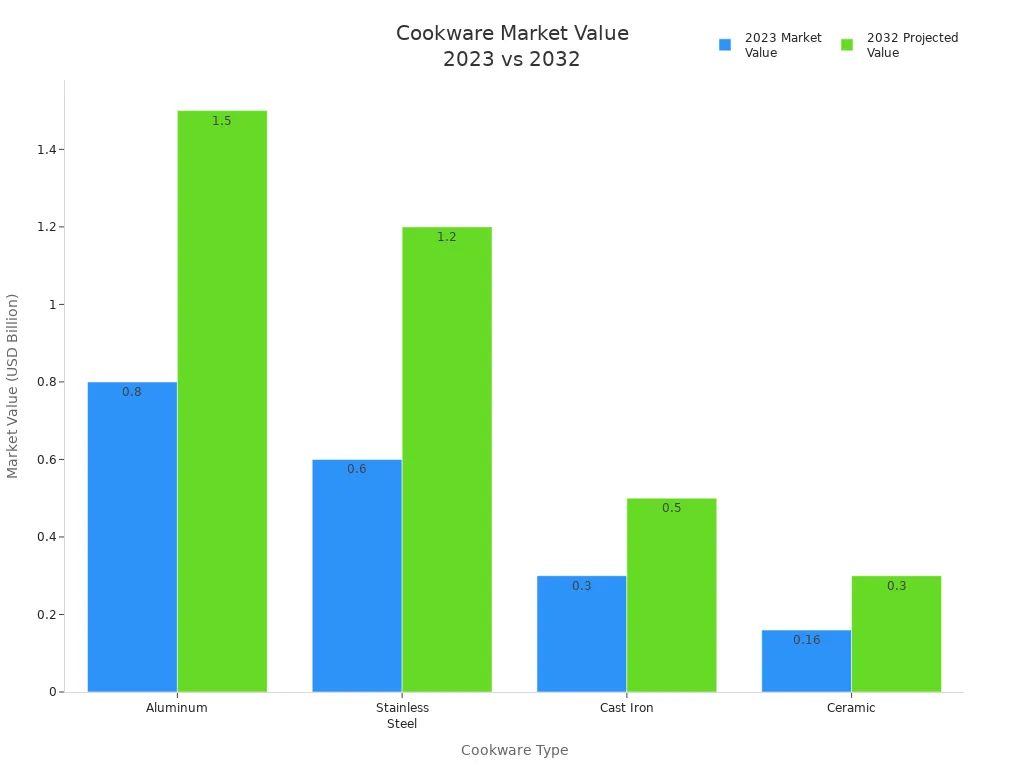
You want a safer kitchen. Choosing a ceramic cookware set helps you avoid toxic chemicals and heavy metals. Ceramic cookware does not leach harmful substances into your food. Pure ceramic kitchenware offers health benefits by keeping your meals clean. Cooking in ceramic cookware supports a healthier lifestyle with every meal.
Health Benefits of Cooking in a Ceramic Cookware Set
Toxin-Free and Chemical-Free Cooking
You want to protect your family from harmful chemicals in the kitchen. A ceramic cookware set gives you peace of mind because it is free from toxins like PFOA, PTFE, lead, and cadmium. When you choose pure ceramic cookware, you avoid the risks that come with many traditional cookware materials. Regulatory agencies like the FDA and California Proposition 65 set strict limits for lead and cadmium in ceramic cookware. They do not allow any leachable lead in cookware sold in the United States. Third-party certifications, such as NSF International, add another layer of safety.
- Ceramic cookware set brands like Caraway Home, Green Pan, and GreenLife have passed tests showing no detectable PFOA, PTFE, lead, or cadmium.
- State laws ban the intentional use of PFAS in cookware.
- Third-party tests confirm that high-quality ceramic-coated cookware does not contain harmful toxins.
| Brand | PFOA | PTFE | Lead | Cadmium | Other Metals Detected |
|---|---|---|---|---|---|
| Green Pan | No | No | No | No | Barium, Chromium, Antimony, Titanium |
| GreenLife | No | No | No | No | Zinc, Copper, Iron, Titanium, Platinum, Manganese |
You can trust that a ceramic cookware set supports your health by keeping your food free from dangerous chemicals. This is one of the most important benefits for anyone who cares about safety in the kitchen.
Tip: Always buy ceramic cookware from reputable brands that meet FDA and state safety standards for the best protection.
Non-Reactive Surface for Healthier Meals
You want your meals to taste fresh and natural. Ceramic cookware gives you a non-stick cooking surface that does not react with your food. This means you can cook acidic dishes like tomato sauce or lemon chicken without worrying about metal leaching or flavor changes. Research shows that ceramic cookware provides an inert, non-reactive surface. This prevents chemical reactions with acidic or alkaline foods, so your meals keep their true taste and nutrients.
Pure ceramic cookware stands out because it does not alter the flavor or color of your food. Unlike aluminum or copper cookware, which can leach metals into your food, ceramic keeps your meals safe and delicious. You get the health benefits of cooking without unwanted chemicals or metal migration.
- Cooking with ceramic cookware helps you avoid nutrient loss.
- You can prepare a wide range of recipes, from soups to stir-fries, with confidence.
- The non-stick cooking surface makes cleanup easy and reduces the need for extra oils or fats.
No Release of Harmful Fumes or Metals
You want a kitchen that is safe for everyone, including pets and children. Ceramic cookware does not release harmful fumes or metals, even at high temperatures. Unlike PTFE-coated nonstick pans, which can emit toxic gases when overheated, ceramic-coated cookware remains stable and safe. Studies show that high-quality ceramic cookware does not leach dangerous metals like nickel, chromium, lead, or cadmium during cooking. Regulatory frameworks in the US and Europe require ceramic cookware to meet strict standards for food safety.
- PTFE and PFOA, found in many nonstick pans, can release toxic fumes above 250°C, causing health problems.
- Ceramic cookware does not contain these chemicals, so you never have to worry about fumes or smoke.
- Ceramic coatings use safe materials like silicon dioxide, which do not break down or release toxins under normal cooking conditions.
| Temperature (°C) | Toxic Gas Emitted | Health/Environmental Impact |
|---|---|---|
| Above 250-290 | Toxic fumes begin | Respiratory harm |
| 350+ | Smoke emission | Increased toxic gas |
| 400+ | PTFE breakdown | Toxic gas formation |
| 500+ | Carbonyl fluoride | Highly toxic |
| 600+ | Hydrogen fluoride | Highly poisonous |
You can cook with confidence, knowing that your ceramic cookware set keeps your kitchen air clean and your food safe. This is a smart choice for anyone who values health and safety at home.
Ceramic Cookware Set vs. Other Cookware: Health and Safety Comparison

Ceramic vs. Non-Stick (Teflon) for Health
You want to keep your kitchen safe and your meals healthy. Non-stick (Teflon) cookware uses PTFE, a chemical that can release toxic fumes if you overheat the pan or scratch the surface. These fumes can harm your lungs and may even affect your pets. Some non-stick pans also contain PFAS chemicals, which have links to cancer and hormone problems. Ceramic cookware gives you a safer choice. It does not use PTFE or PFOA. You can cook at high heat without worrying about harmful chemicals entering your food or the air. Ceramic-coated cookware offers a non-toxic surface, so you can enjoy peace of mind every time you cook.
Tip: Choose ceramic cookware if you want a nonstick surface without the health risks of Teflon.
Ceramic vs. Stainless Steel in Healthy Cooking
Stainless steel cookware is strong and lasts a long time. However, it can leach small amounts of nickel and chromium into your food, especially if you cook acidic dishes or use new pots. Some people are sensitive to nickel and may get allergic reactions. Ceramic cookware stands out because it does not leach metals. Pure ceramic cookware is made from clay and minerals fired at high temperatures, removing heavy metal impurities. You get a non-reactive surface that keeps your food pure and safe. Both types of cookware are good for healthy cooking, but ceramic gives you extra protection from metal leaching.
| Cookware Type | Metal Leaching | Non-Toxic Surface | Best For |
|---|---|---|---|
| Stainless Steel | Possible | Yes | High-heat searing |
| Ceramic | No | Yes | Low-fat, nonstick meals |
Ceramic vs. Cast Iron: Health Considerations
Cast iron cookware adds iron to your food. This can help if you need more iron in your diet. However, too much iron can be a problem for people with certain health conditions, like hemochromatosis. Acidic foods make cast iron leach even more iron. You also need to care for cast iron to avoid rust and extra metal in your meals. Ceramic cookware does not leach iron or other metals. It is non-reactive and safe for everyone, including those who need to avoid extra iron. You can trust a ceramic cookware set to keep your food clean and your health protected.
Practical Advantages for Healthy Cooking in Ceramic Cookware
Even Heat Distribution and Energy Efficiency
You want your meals to cook evenly every time. Ceramic cookware gives you this advantage. The dense material in pure ceramic cookware holds heat well and spreads it across the pan. This means your food cooks thoroughly, with no hot or cold spots. You get better results, especially for slow-cooked dishes and baking. Many ceramic-coated pans use an aluminum core. This design heats up quickly and saves energy during cooking. You can prepare eggs, pancakes, or stir-fries with less waiting and less wasted heat.
- Ceramic cookware keeps food warm longer after you turn off the stove.
- You use less energy because the heat spreads evenly and stays consistent.
- Pure ceramic cookware works best for slow cooking and baking, while ceramic-coated pans excel at quick, low to medium heat tasks.
| Cookware Type | Heat Conductivity | Heat Retention | Energy Efficiency Characteristics |
|---|---|---|---|
| Ceramic | Heats quickly (aluminum base) | Poor heat retention | Efficient for quick, low to medium heat cooking; not suitable for high-heat tasks like searing |
| Stainless Steel | Poor conductor alone; improved with aluminum/copper core | Good heat retention (multi-layer) | Versatile and energy-efficient for searing, browning, and even heating due to tri-ply construction |
| Cast Iron | Slow to heat | Excellent heat retention | Energy-efficient for slow cooking; retains heat well, reducing energy needed to maintain temperature |
| Non-Stick (Ceramic & Traditional) | Heats quickly | Moderate (coating degrades over time) | Allows cooking at lower temperatures, saving energy for short tasks; efficiency decreases as coating wears |
Easy Cleaning for Healthier Cooking
You want a kitchen that is easy to clean and safe for your family. Ceramic cookware makes this possible. The non-porous, smooth surface of pure ceramic cookware stops food from sticking and keeps bacteria away. You can wash it with mild soap and water, making it easy to clean after every meal. This surface also supports easy food release, so you spend less time scrubbing and more time enjoying your food.
- You reduce the risk of cross-contamination because ceramic cookware does not hold onto gluten or bacteria when cleaned properly.
- Most kitchenware, including ceramic, stays safe for gluten-free cooking with standard cleaning.
- The easy-to-clean surface means you keep your kitchen healthier and your meals safer.
Tip: Always clean your ceramic cookware with hot, soapy water to keep it easy to clean and free from harmful residues.
Addressing Lead, Cadmium, and Food Safety Certification
You deserve peace of mind when using ceramic cookware. Strict rules in the United States and Europe set safe limits for lead and cadmium in all ceramic kitchenware. Manufacturers must test their products and provide proof that they meet these standards. If a product fails, it must carry a warning label and cannot be sold for food use.
| Jurisdiction | Regulation | Lead Limit | Cadmium Limit | Additional Notes |
|---|---|---|---|---|
| USA (FDA) | 21 CFR Part 109 | Varies by product type, e.g., cups/mugs: 0.5 µg/mL | Varies, e.g., large hollowware: 0.25 µg/mL | Limits apply to migration of metals into food; testing required |
| California (Prop 65) | OEHHA MADLs | 0.5 µg/day | 4.1 µg/day | Sets maximum allowable dose levels for exposure from consumer products |

Food safety certifications protect you from heavy metal exposure. Testing labs check for lead and cadmium leaching. Only cookware that passes these tests earns certification. You can trust certified ceramic cookware to keep your food safe and your kitchen healthy.
You want the healthiest kitchen. Ceramic cookware gives you a non-toxic, easy-to-clean, and safe cooking experience. Consumer Reports and Organic Authority recommend it for health-conscious cooks. While ceramic holds a smaller market share, its popularity grows as more people choose safer, PFAS-free options.

- Ceramic cookware avoids harmful chemicals found in Teflon.
- Top brands earn high safety ratings.
- You support a cleaner, healthier kitchen every day.
FAQ
Is ceramic cookware safe for daily use?
You can use ceramic cookware every day. It does not leach harmful chemicals. You keep your meals safe and your kitchen healthier.
Can you use ceramic cookware on all stovetops?
You can use most ceramic-coated pans on gas, electric, and glass stovetops. Always check the manufacturer’s instructions for induction compatibility.
Tip: Always lift ceramic pans instead of sliding them to protect your stovetop and cookware.
How do you keep ceramic cookware nonstick?
You keep the nonstick surface by using low to medium heat. Avoid metal utensils. Wash with soft sponges and mild soap for best results.


